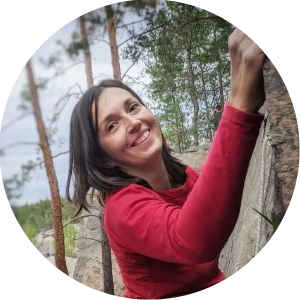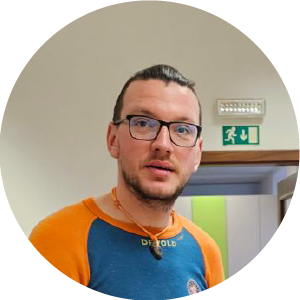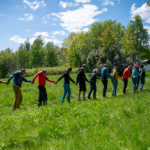Study-tour “Environmental education: experience of leading European national parks”
From April 15 to 18, 2025, the Slovak-Ukrainian team of the project Green Treasures of the Carpathians visited the Bavarian Forest and Šumava National Parks. The goal of the internship was to gain inspiration in experiential environmental education and learn from the experiences of German and Czech colleagues, who are among Europe’s leaders in this field and have a wealth of knowledge to share. A rich interactive programme was prepared for the participants, offering a deeper understanding of nature pedagogy based on simple yet effective nature games. These activities help children engage all their senses to explore nature, allowing spontaneous discovery as well as creative learning, imagination development, and the acquisition of new skills.
One of the greatest strengths of these parks is the passionate and dedicated people working there. Their enthusiasm for nature is contagious, and they manage to pass it on to children and visitors. For example, through play, children are invited to become forest animals for a while – an experience that helps them understand these creatures on a deeper level. This approach enables an entirely different kind of learning. All that’s needed is a beautiful spot in nature and simple tools such as chestnuts, wooden clips, or small mirrors. With great methodology, children not only have fun but also learn a lot – for example, how a deer sees, or what it’s like for a squirrel or bear to search for food.
They enjoy movement, release endorphins, and marvel at the beauty of the forest, which changes every day.
After the activities, participants engage in reflection, where well-structured open-ended questions give children the space to think about nature and our place in it. They learn to perceive environmental challenges, react to them, present their thoughts, collaborate, argue respectfully, communicate effectively, and reevaluate their attitudes. These games also integrate different school subjects. When children are truly engaged, they forget about their phones. And if they need to identify a plant species, they learn how to use digital tools effectively and purposefully.
In addition to nature pedagogy and practical training, participants also visited modern environmental classrooms, outdoor schools, visitor centres, and wildlife enclosures in natural habitats – all facilities developed by the national parks to engage the public. The visit also included the Forest History Museum in St. Oswald, a welcome opportunity to explore the history of the German-Czech borderlands, now united as two national parks often referred to as the “Green Heart of Europe”, protecting the largest contiguous forest area in Central Europe.
The entire study-tour took place in a very pleasant and inspiring atmosphere, with time for discussion and reflection. Participants left with a wealth of impressions, practical advice, and ideas for implementing in the Green Treasures of the Carpathians project. All agreed that cooperation with colleagues from the Bavarian Forest and Šumava is invaluable, and they look forward to further collaboration and knowledge exchange.
Participant Reflections

Nadiia Chaban, designer and sports activities instructor of the project
The study-tour in Šumava National Park was a powerful experience for me – a mix of sorrow and inspiration. Sorrow, because in Ukraine, due to the war, developing natural parks is very difficult. Even in the High Tatras, where I currently live, there are many untapped opportunities. But also great inspiration – especially from the Šumava team, who work with incredible dedication even after 20 years, and from their approach to children’s education.
I was especially enchanted by their educational materials – beautifully illustrated, created with love and empathy for children. They include not only textbooks, but also memory games, wooden animal figures, puzzles, seasonal calendars, and interactive games. Every element is thoughtfully designed to support experiential learning. I imagine how amazing it would be to create something similar for Carpathian children – to help them explore nature joyfully and playfully.
After this journey, I feel a strong motivation to help make the Carpathians a better place for children – on both sides of the border.
 Maria Benčatova, methodologist, trainer and editor of the project
Maria Benčatova, methodologist, trainer and editor of the project
Thanks to the study-tour, I had the opportunity to observe the work of educators in the Bavarian Forest and Šumava national parks. What impressed me most was the simplicity and effectiveness of their nature-based games – children become part of the forest, engage all their senses, and naturally develop a connection to nature. With small props (chestnuts, mirrors, clips), they understand the world of animals, movement in the forest, and ecosystems.
 A strong component was reflection – children are given space to express themselves, learn to collaborate, argue, connect knowledge, and respect different viewpoints. Cross-disciplinary learning is strongly supported. I was also impressed by the connection to school curricula – the programmes are planned with teachers, and children spend a full week in nature. Thanks to volunteers, they work in small groups, allowing for an individual approach.
A strong component was reflection – children are given space to express themselves, learn to collaborate, argue, connect knowledge, and respect different viewpoints. Cross-disciplinary learning is strongly supported. I was also impressed by the connection to school curricula – the programmes are planned with teachers, and children spend a full week in nature. Thanks to volunteers, they work in small groups, allowing for an individual approach.
In Šumava, we saw excellent methodologies and materials for children from kindergarten to university. I look forward to the possibility of adapting the ‘Let’s Start from the Forest’ method for our context.

Jakub Tomaškovič, mountain guide
What truly surprised me in a positive way was their holistic approach to nature conservation – it doesn’t stop at signs and prohibitions. It includes preserving culture, landscapes, history, and especially educating the next generation.
The system of environmental education we witnessed – from outdoor schools, through environmental classrooms, to top-notch visitor centres and museums – shows that it’s possible to do this work with love, professionalism, and public cooperation. And when you add wild animals in their natural habitat, open for observation, you have a recipe for creating deep human-nature connections.A big thank-you goes to all the amazing people we met – they do their work with passion and inspire us to keep moving forward.
Study-tour was organised in the framework of Green Treasures project supported by INTERREG/HUSKROUA programme























 Previous Post
Previous Post Next Post
Next Post